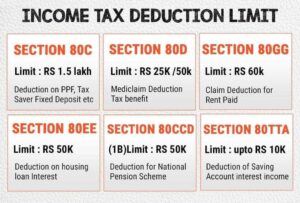 Explore lesser known tax saving tips beyond Section 80C investments like PPF and ELSS, such as Section 80GG for rent expenses, Section 80D for medical insurance premiums, and Section 80CCD(1B) for NPS contributions.
Explore lesser known tax saving tips beyond Section 80C investments like PPF and ELSS, such as Section 80GG for rent expenses, Section 80D for medical insurance premiums, and Section 80CCD(1B) for NPS contributions.
While many are familiar with common tax-saving avenues such as Section 80C investments like PPF, ELSS, HRA, or home loan interest, there exist lesser-known strategies that can significantly benefit individuals seeking to minimise their tax burden. Today, we’ll delve into five such lesser-known tax-saving tips that can assist not only employees but also business owners and freelancers in legally reducing their tax liabilities.
For individuals who haven’t yet purchased a house and incur substantial expenses on rent, there exists a beneficial provision within the Income Tax Act known as Section 80GG. This provision is particularly relevant for salaried employees without House Rent Allowance (HRA) or for self-employed individuals, freelancers, and business owners who reside in rented accommodations.
Under Section 80GG, individuals can claim income tax exemptions if they meet certain criteria. There are three conditions specified, and the least amount among these conditions determines the extent of the exemption.
Condition 1: Annual rent paid minus 10% of total income.
Condition 2: ₹5,000 per month.
Condition 3: 25% of total income.
To illustrate, suppose an individual has an annual income of ₹5 lakhs and pays ₹10,000 in monthly rent. The calculations proceed as follows:
1. Annual rent paid: ₹10,000 x 12 = ₹1,20,000 subtracting 10% of total income (10% of ₹5 lakhs = ₹50,000): ₹1,20,000 – ₹50,000 = ₹70,000
2. Second condition: ₹5,000 per month x 12 = ₹60,000
3. Third condition: 25% of total income (25% of ₹5 lakhs = ₹1,25,000)
The least among the three conditions is ₹60,000. Hence, the exemption under Section 80GG amounts to ₹60,000.
However, it’s important to note two conditions before claiming the exemption. Firstly, if the individual, their spouse, or minor child owns a house property in the location where they reside, they are ineligible for this exemption. Secondly, if the individual has a self-occupied house property and hasn’t declared any rental income for it in their Income Tax Return (ITR), it implies they reside in that property and are thus ineligible for the exemption. Therefore, understanding and fulfilling these conditions is crucial when considering the exemption under Section 80GG.
The Income Tax Act offers tax-saving opportunities beyond the commonly known deduction for medical insurance premiums. While it’s well-known that premiums for medical insurance policies are eligible for deductions under this section, there’s an additional component that many overlook. Let’s delve into the intricacies of Section 80D.
If you, your spouse, or dependent children hold medical insurance policies and you’re below the age of 60, you can claim an annual deduction of up to ₹25,000. Moreover, if you also pay the premium for your parents’ policies, an additional ₹25,000 deduction is available. Notably, if your parents are senior citizens, the deduction limit increases to ₹50,000.
For instance, if your insurance premium for a ₹5 lakh cover amounts to ₹14,280 annually, the deduction cannot exceed this premium. However, Section 80D encompasses another beneficial aspect: preventive health check-ups. If you, your spouse, children, or parents undergo a comprehensive health check-up, you can claim a deduction of up to ₹5,000.
Consider this scenario: You undergo a full-body check-up, incurring a cost of ₹5,000, and discover a health concern such as dangerously low vitamin B12 levels. Subsequently, after seeking treatment and achieving normal vitamin levels, your total deductible amount under Section 80D becomes ₹19,280 (comprising both the insurance premium and the health check-up cost).
To ensure eligibility for Section 80D benefits, it’s imperative that the premium payments are made via bank transfer, while preventive health check-up expenses can be paid in cash. Additionally, individuals can verify their deduction amounts under Section 80D by visiting the income tax website. By leveraging Section 80D provisions, individuals can not only save on taxes but also prioritise their health and well-being.
You may already be aware that by utilising Section 80C and its associated avenues, you can claim a deduction of up to ₹1.5 lakhs. These deductions are typically derived from investments in instruments like PPF, ELSS, among others. However, what many overlook is the additional tax-saving opportunity provided by Section 80CCD(1B), which allows for an extra deduction of ₹50,000 specifically for contributions made towards the National Pension System (NPS).
In essence, if you’ve already exhausted the ₹1.5 lakh limit under Section 80C and still wish to further reduce your taxable income, investing ₹50,000 in the NPS can unlock this additional deduction. It’s important to note that this deduction is applicable only to contributions made to NPS Tier 1 accounts, which come with a lock-in period until the age of 60. Contributions to NPS Tier 2 accounts, which do not have such lock-in periods, do not qualify for this deduction.
Therefore, if you’re considering maximising your tax-saving potential, exploring the benefits offered by Section 80CCD(1B) and investing in NPS Tier 1 accounts can prove to be a prudent financial move. By doing so, you not only secure your retirement but also optimise your tax planning efforts effectively.
In conclusion, Section 80 of the Income Tax Act of India encompasses various provisions aimed at reducing the tax burden on individuals and encouraging savings and investments. From deductions on investments in tax-saving instruments like PPF, ELSS, and NPS under Section 80C to additional benefits such as those for medical insurance premiums under Section 80D and long-term capital gains under Section 80CCD(1B), taxpayers have numerous opportunities to optimise their tax planning strategies.
Source: https://www.livemint.com/money/personal-finance/income-tax-return-5-lesser-known-tax-savings-tips-from-section-80-investments-itr-tax-planning-ppf-elss-nps-11712574261576.html
© 2018 CA Chandan Agarwal. All rights reserved.